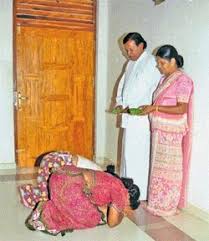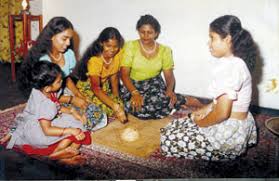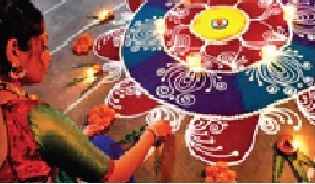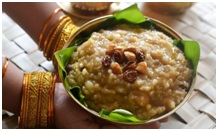A vibrant celebration of two cultures - Sinhala & Tamil New Year
The Sinhala and Tamil New Year is a season of celebration and joy to everyone all over Sri Lanka irrespective of age, colour or religion. It is indeed an opportunity to strengthen the bond between the Sinhala and Tamil communities. The Rotaract Mora blog brings you this exploration of two cultures through the words of two of our very own Rotaractors. One of them will tell you all about how the Sinhalese celebrate this festival, and the other will walk you through the Tamil cultural aspect of this wonderful celebration.
As told by Rtr. Yoshani Ranaweera
Since ancient times, the time and seasons were counted based on the Sun. The Sun festival was a common practice carried out by most races since prehistoric times, owing to the reason that the Sun was considered as God.
With the evolution of such practices, Sri Lankans have come to celebrate the Sinhala and Hindu New Year on the 13th and 14th of April, which is a festival based upon the journey of the Sun. The New Year marks the transition of the Sun from Meena (Pisces) to Mesha (Aries) in the Zodiac. All Sri Lankans join in unity to celebrate this prosperous festival by holding various events and preparations for over a week before and after the respective date.
Prior to the day of the Sinhala New Year, it is a practice for women to prepare various Awurudu treats that include mouth-watering sweets like Athirasa, Kewum, Kokis and so much more. The dawn of the New Year is heralded by the heart-warming cry of the cuckoo bird. The rituals associated with the New Year are carried out at auspicious times prescribed by astrologers. The time period in which there are no auspicious times is called the “Nonagathaya” and during this period it is preferable to engage in meritorious activities.

The inauspicious time is declared over when the New Year dawns, and it is celebrated by preparing milk-rice and a table is set with the other sweetmeats prepared earlier. During this time, the unity between family members is highly asserted. The next ritual is for all younger people to worship their elder, emphasizing the fact that younger ones should respect their elders.

As the custom continues, after the day of the New Year, Sinhalese people visit their relatives’ and friends’ homes, exchanging gifts and thus maintaining the bond between them. Also, during this time Awurudu Festivals are conducted by various gatherings of people. The people carry out various games such as Kana Mutti, Pancha-Keliya and Kotta-pora which are specific to the New Year Festival, during these gatherings.

As evident, the Sinhala and Hindu New Year festival highlights the harmony between people. During this period, enemies become friends and friends become best friends, thus emphasizing the importance of the event.
As told by Rtr. Narmadha Rajakanthan
The days leading up to the Sinhala and Tamil New Year are fun, yet rather frantic, with tons of cooking, plenty of cleaning, a good deal of shopping and trying not to forget to get the “Maruthuneer” from the temple

The New Year is born at the time of the “Mesha Sangrandhi” or the spring equinox when the sun ventures from Pisces to Aries. The first ritual of the New Year’s day is the anointing of ”Maruthuneer” or holy herbal oil on household members’ head by the household elder. The herbs used in the oil, as well as the leaf used for anointing, is specific for each year. Following the first bath of the year, a prayer is sent to the sun with the dedication of flowers. The entrance of the house is then decorated with coloured rice patterns or “Kolam”, the Kumbham is kept and oil lamps are lit. The Kumbham is a pot filled with water with a coconut on its mouth and a coronet of five or seven mango leaves. It represents Lord Ganesh or Goddess Gauri blessing the household with life, fertility, prosperity, wisdom and wealth.

Once the Kumbham is set up, the hearth is lighted for the first time of the year. Milk is boiled and “Pongal” (sweetened milk rice) is made. The dish can be sweetened with jaggery (Sakkaraipongal) or sugar (Venpongal). Cardamon and cloves add more flavour while roasted gram and cashew nuts add a crunch. Raisins add bursts of sweetness that is loved by the older members of the family much to the dismay of the younger ones. The dish denotes the abundance of the harvest, similar to Christmas cake or Kiribath.

After this, the first transaction of the year occurs. The younger members of the house pay their respects to the elders, and the elders bless them and give a “kai-visesham”, a gift of money and beetle leaves. Alongside this “arpudu” or ploughing of the field for the first time of the season occurs.

No celebration is complete without food, and the New Year is no exception. Sweetmeats such as Pongal, Ladoo, Murukku, Kesari, mixture and other such festivities are shared among family, friends and neighbours. Families visit the temple to pray and give their greetings to others in the community. The rest of the day is spent visiting family and friends, participating in games such as “Porthenkai” (coconut wars) and cart races.
The two vibrant cultures combined together makes this splendid celebration extra special. Thus, we as Sri Lankans always make sure that we celebrate this joyful occasion with peace and harmony, adding the essence of this celebration to our lives throughout the new 365 days that lie ahead of us.



